So what is love, actually?
It is relative, diverse and and has countless definitions It’s a kind of biological bribery that helps a species to cooperate to survive, to reproduce and to raise children

Experts say the Western ideal of romantic love is constantly disappointing us. Which is a shame because western culture loves romantic love. It’s an idea that pervades pop music, novels, TV and film. Somewhere out there our perfect match is waiting to meet us, so the theory goes. But maybe love isn’t really about The One. Maybe the early films of Richard Curtis don’t have all the answers.
So what is love, actually? There are many answers to this question, says the anthropologist Anna Machin, but let’s start with an evolutionary explanation. Basically, love helps a species to cooperate. “We need to cooperate to survive, to subsist, to learn, to reproduce and to raise our children,” she says. “Romantic and parental love is essentially the neurochemical reward for cooperating, which is cognitively quite difficult.” It’s a kind of biological bribery, in other words.
Love is the deepest animal attachment, distinct from lust or sex drive. But forget about the myth of love at first sight, Machin says. “There is lust at first sight. When someone experiences lust, their amygdala — the ancient, central part of the brain responsible for emotion — is releasing the neurochemicals dopamine and oxytocin. Dopamine is a general reward chemical, which makes you feel euphoric, warm and motivated to form a relationship with someone. Oxytocin works to lower your inhibitions to forming a relationship.” This attraction, Machin explains, is triggered by physical signs of a good mate, such as a bigger waist-hip ratio in women or a highly symmetrical face.
The neurochemical processes of love are more complex, and last longer than lust. As well as the amygdala, love involves the neocortex — the part of the brain responsible for social cognition. “That’s where all the trust, empathy, planning ahead and trying to coordinate your life with the person you’re in love with sits,” says Machin.
During love, the prefrontal cortex (at the front of the brain) begins to release an opiate called beta-endorphin. “Beta-endorphin is addictive,” Machin says, “so when you’re in love with someone, you are addicted to the release of beta-endorphin you receive when you interact with them. When you’re away from them, you go into a kind of withdrawal. When you go back, you get another hit.”
Our experiences of love are influenced by factors beyond spontaneous emotion. Jess Carbino, a sociologist who works for the dating app Bumble, says the way we seek love is complex, but it’s “a romantic myth” to call it random. “People are very deliberate about finding love,” she says. “When we are looking for romantic partners, for example, people are very realistic about who they look for in the dating market, based on their own physical attractiveness.”
Carbino reckons this dating market has always existed in some form; the advent of online dating apps just made it more visible. “In theory, prior to the emergence of online dating, people were speculating about what the market was because they could only see a fraction of it. Now you’re embedded in a variety of markets online — not just your work market or your religious market, but every market available within a geographic radius within the age and gender you’re looking for.”
There is no algorithm for love, though both our experiences and our genetics influence our preferences in a partner. In her book Anatomy of Love, the biological anthropologist Helen Fisher calls this our “love map”. She writes: “[A]s you grow up, you build a conscious [and unconscious] list of traits you are looking for in a mate; then, with time and experiences, this vision of an ideal partner crystallises. Drugs can’t change these memories, these experiences, this mental template.”
It is these differing expectations and experiences that can cause relationships to fail, says Kathrine Bejanyan, a relationship consultant. “Where I see the biggest problem is not necessarily people falling in love, it’s sustaining it,” she explains. These clashes can stem from our family upbringing, for instance. “Say you grew up in a family where love was shown through giving gifts when you got a good grade, that person experienced gift-giving as an expression as love. Another person with a different upbringing might understand love and how to receive it differently.”
From a theological perspective, says Werner Jeanrond, a Catholic theologian at Oxford University, “love invites us to a much deeper way of seeing”. Jeanrond says all forms of love are united and defined “by the challenge of otherness” (the “other” being the opposite of the self). Jeanrond argues that love involves engaging with otherness in at least four ways. “There is the other human being, in an intersubjective relationship. Then there is our relationship to the cosmos or the universe or nature. Then there is the question of God or ultimate reality — how can you relate to the radical other? And most problematic is our relationship to ourselves — can I love me?”
The opposite of love is therefore not hatred but indifference, Jeanrond says. “I think people see that wrongly. Hatred is a warped love, but it is still interested and obsessed with the other. Indifference is the opposite of love because they don’t even see the other.”
As Jeanrond points out, love is relative, diverse and not always conspicuous. It has countless definitions, depending on who you ask. But perhaps the real mystery is how these definitions fit together.
— Guardian News & Media Ltd
Alfie Packham is the editor of Guardian Students.
Sign up for the Daily Briefing
Get the latest news and updates straight to your inbox



